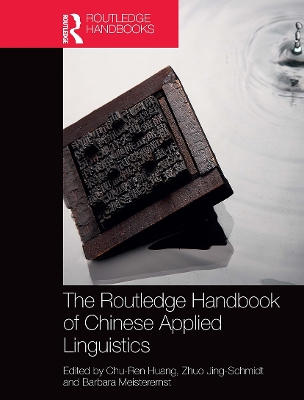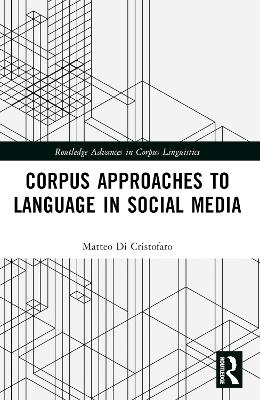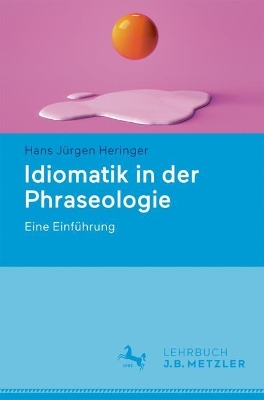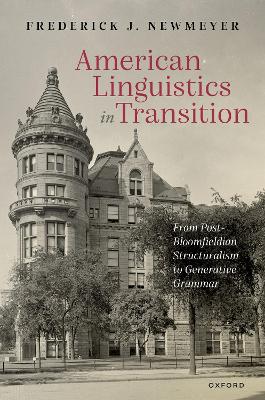Routledge Handbook of Chinese Applied Linguistics
 portes grátis
portes grátis
Routledge Handbook of Chinese Applied Linguistics
Meisterernst, Barbara; Jing-Schmidt, Zhuo; Huang, Chu-Ren
Taylor & Francis Ltd
08/2022
810
Mole
Inglês
9781032401607
15 a 20 dias
1500
Descrição não disponível.
Introduction Chapter: Language in Action, Language in Context
Chu-Ren Huang (The Hong Kong Polytechnic University) Zhuo Jing-Schmidt (University of Oregon), and Barbara Meisterernst (National Tsinghua University)
Language, Culture and Society
Chapter 1. Chinese Philosophy, Religions and Language Friederike Assandri (University of Leipzig) and Barbara Meisterernst (National Tsinghua University)
Chapter 2. Chinese Language and Buddhism Jiandao (Luminary Research Institute, Gaya Foundation), Jianxun (Luminary Research Institute, Gaya Foundation), and Jiajuan Xiong (South Western University of Finance & Economics)
Chapter 3. Chinese Language and Christianity Federico Masini (Sapienza University of Rome)
Chapter 4. Chinese Language and the Silk Roads Barbara Meisterernst (National Tsinghua University)
Chapter 5. Chinese, Food and Menus Yao Yao (The Hong Kong Polytechnic University) and Qi Su (Peking University)
Chapter 6. Chinese Language and Fruits Shelley Ching-yu Depner (National Cheng Kung University)
Chapter 7. Colour Terms in Chinese Huei-ling Lai (National Chengchi University)
Chapter 8. The Function of Poetic Language and Rhymes in Pre-Modern Chinese Literature Barbara Meisterernst (National Tsinghua University)
Chapter 9. Chinese Cultures of Learning: Elicited Metaphor Research Lixian Jin (University of Nottingham Ningbo China) and Martin Cortazzi (University of Nottingham Ningbo China)
Chapter 10. Learning "Chinese" as a Heritage Language: Challenges, Issues and Ways Forward Patricia Duff (University of British Columbia) and Liam Doherty (University of British Columbia)
Chapter 11. Chinese Language and Gender Research Marjorie K.M. Chan (The Ohio State University) and Yuhan Lin (The Ohio State University)
Chapter 12. Varieties of Chinese: Dialects or Sinitic Languages? Maria Kurpaska (Adam Mickiewicz University in Poznan)
Chapter 13. Variations in World Chineses Jingxia Lin (Nanyang Technological University), Dingxu Shi (Guangdong University of Foreign Studies), Menghan Jiang (The Hong Kong Polytechnic University) and Chu-Ren Huang (The Hong Kong Polytechnic University)
Chapter 14. Chinese Language and New Immigrants Chin-Chin Tseng (National Taiwan Normal University) and Chen-Cheng Chun (National Kaohsiung Normal University)
Chapter 15. Chinese Language and Social Justice Susan D. Blum (University of Notre Dame)
Language: Expression, Communication and Persuasion
Chapter 16. Chinese Language Arts: The Role of Language and Linguistic Devices in Literary and Artistic Expressions Chu-Ren Huang (The Hong Kong Polytechnic University), Kathleen Ahrens (The Hong Kong Polytechnic University), Tania Becker (Technical University of Berlin), Regina Llamas (Stanford University), King-fai Tam (The Hong Kong Polytechnic University) and Barbara Meisterernst (National Tsinghua University)
Chapter 17. Chinese Multimodal Resources for Discourse Act Analysis Alex Chengyu Fang (City University of Hong Kong), Yanjiao Li (Shandong University at Weihai), Jing Cao (Zhongnan University of Economics and Law) and Harry Bunt (Tilburg University)
Chapter 18. Chinese and Counterfactual Reasoning Yan Jiang (SOAS University of London)
Chapter 19. Linguistic Synaesthesia in Chinese Chu-Ren Huang (The Hong Kong Polytechnic University) and Jiajuan Xiong (South Western University of Finance & Economics)
Chapter 20. Chinese and Emotion Analysis Sophia Yat Mei Lee (The Hong Kong Polytechnic University)
Chapter 21. Humour in Chinese Lingling Ge (University of South China) and Yuanjian He (University of Macau)
Chapter 22. Irony in Chinese Languages: An Overview and a Case Study I-Wen Su (National Taiwan University) and Shuping Huang (National Sun Yat-sen University)
Chapter 23. Metaphor in Chinese Kathleen Ahrens (The Hong Kong Polytechnic University) and Siaw-Fong Chung (National Chengchi University)
Chapter 24. Commendatory and Derogatory Expressions in Chinese Janet Zhiqun Xing (Western Washington University)
Chapter 25. Cursing, Taboo and Euphemism Zhuo Jing-Schmidt (University of Oregon)
Chapter 26. Chinese for Specific Purposes: A Broader Perspective Haidan Wang and Song Jiang (University of Hawai?i at Manoa)
Chapter 27. Chinese Translation in the Twenty First Century Weixiao Wei (Taiyuan University of Technology) and Chris Shei (Swansea University)
Chapter 28. The Study of Chinese Language Advertisements Doreen Wu (The Hong Kong Polytechnic University) and Chaoyuan Li (Xi'an International Studies University)
Chapter 29. Chinese Communication in a Globalizing World: An Outline of an Emerging Contemporary Chinese Discourse Shi-xu (Hangzhou Normal University)
Language, Computer and New Media
Chapter 30. Computer and Chinese Writing System Qin Lu (The Hong Kong Polytechnic University)
Chapter 31. Digital Language Resources and NLP Tools Chu-Ren Huang (The Hong Kong Polytechnic University) and Nianwen Xue (Brandeis University)
Chapter 32. Information Quality: Linguistic Cues and Automatic Judgments Qi Su (Peking University)
Chapter 33. Chinese Neologisms Zhuo Jing-Schmidt (University of Oregon) and Shu-kai Hsieh (National Taiwan University)
Chapter 34. Online Language Resources: Advances, Applications and Challenges Weidong Zhan (Peking University), Xiaojing Bai (Tsinghua University)
Chapter 35. The Impact of Information and Communication Technology on Chinese Language Life Jingwei Zhang (University of Macau) and Daming Xu (University of Macau)
Language, Mind and Body
Chapter 36. Chinese and Aphasia Sam-Po Law (The University of Hong Kong) and Anthony Pak-Hin Kong (University of Central Florida)
Chapter 37. A Study of Syntactic Ability and Its Relation to Theory of Mind in Cantonese-speaking Children with Autism Spectrum Disorder Mantak Leung and Honglan Li (The Hong Kong Polytechnic University)
Chapter 38. Language and the Brain in the Sunset Years William S.-Y. Wang (The Hong Kong Polytechnic University)
Chapter 39. Concept Composition during Language Processing: Two Case Studies and a Model Maria Mercedes Pinango (Yale University)
Chapter 40. Chinese Reading Acquisition Chia-ying Lee (Academia Sinica)
Chapter 41. Neural Mechanisms for the Processing of Chinese Wei Zhou (Capital Normal University), Linjun Zhang (Beijing Language and Culture University), Hua Shu (Beijing Normal University), and Ping Li (Pennsylvania State University)
Chapter 42. Tone and Music Processing in Chinese Caicai Zhang (The Hong Kong Polytechnic University)
The Sciences of Language
Chapter 43. Chinese Sociolinguistics Daming Xu (University of Macau) Jingwei Zhang (University of Macau)
Chapter 44. Linguistic Anthropology of Chinese Chen-chun E (National United University)
Chapter 45. Chinese Rhetoric Yan Jiang (SOAS University of London)
Chapter 46. Investigating Sign Languages in the Chinese Context Jia Li (The Chinese University of Hong Kong), Jia He (The Chinese University of Hong Kong), and Gladys Tang (The Chinese University of Hong Kong)
Chapter 47.Chinese Psycholinguistics: A Typological Overview Chien-Jer Charles Lin (Indiana University Bloomington)
Chu-Ren Huang (The Hong Kong Polytechnic University) Zhuo Jing-Schmidt (University of Oregon), and Barbara Meisterernst (National Tsinghua University)
Language, Culture and Society
Chapter 1. Chinese Philosophy, Religions and Language Friederike Assandri (University of Leipzig) and Barbara Meisterernst (National Tsinghua University)
Chapter 2. Chinese Language and Buddhism Jiandao (Luminary Research Institute, Gaya Foundation), Jianxun (Luminary Research Institute, Gaya Foundation), and Jiajuan Xiong (South Western University of Finance & Economics)
Chapter 3. Chinese Language and Christianity Federico Masini (Sapienza University of Rome)
Chapter 4. Chinese Language and the Silk Roads Barbara Meisterernst (National Tsinghua University)
Chapter 5. Chinese, Food and Menus Yao Yao (The Hong Kong Polytechnic University) and Qi Su (Peking University)
Chapter 6. Chinese Language and Fruits Shelley Ching-yu Depner (National Cheng Kung University)
Chapter 7. Colour Terms in Chinese Huei-ling Lai (National Chengchi University)
Chapter 8. The Function of Poetic Language and Rhymes in Pre-Modern Chinese Literature Barbara Meisterernst (National Tsinghua University)
Chapter 9. Chinese Cultures of Learning: Elicited Metaphor Research Lixian Jin (University of Nottingham Ningbo China) and Martin Cortazzi (University of Nottingham Ningbo China)
Chapter 10. Learning "Chinese" as a Heritage Language: Challenges, Issues and Ways Forward Patricia Duff (University of British Columbia) and Liam Doherty (University of British Columbia)
Chapter 11. Chinese Language and Gender Research Marjorie K.M. Chan (The Ohio State University) and Yuhan Lin (The Ohio State University)
Chapter 12. Varieties of Chinese: Dialects or Sinitic Languages? Maria Kurpaska (Adam Mickiewicz University in Poznan)
Chapter 13. Variations in World Chineses Jingxia Lin (Nanyang Technological University), Dingxu Shi (Guangdong University of Foreign Studies), Menghan Jiang (The Hong Kong Polytechnic University) and Chu-Ren Huang (The Hong Kong Polytechnic University)
Chapter 14. Chinese Language and New Immigrants Chin-Chin Tseng (National Taiwan Normal University) and Chen-Cheng Chun (National Kaohsiung Normal University)
Chapter 15. Chinese Language and Social Justice Susan D. Blum (University of Notre Dame)
Language: Expression, Communication and Persuasion
Chapter 16. Chinese Language Arts: The Role of Language and Linguistic Devices in Literary and Artistic Expressions Chu-Ren Huang (The Hong Kong Polytechnic University), Kathleen Ahrens (The Hong Kong Polytechnic University), Tania Becker (Technical University of Berlin), Regina Llamas (Stanford University), King-fai Tam (The Hong Kong Polytechnic University) and Barbara Meisterernst (National Tsinghua University)
Chapter 17. Chinese Multimodal Resources for Discourse Act Analysis Alex Chengyu Fang (City University of Hong Kong), Yanjiao Li (Shandong University at Weihai), Jing Cao (Zhongnan University of Economics and Law) and Harry Bunt (Tilburg University)
Chapter 18. Chinese and Counterfactual Reasoning Yan Jiang (SOAS University of London)
Chapter 19. Linguistic Synaesthesia in Chinese Chu-Ren Huang (The Hong Kong Polytechnic University) and Jiajuan Xiong (South Western University of Finance & Economics)
Chapter 20. Chinese and Emotion Analysis Sophia Yat Mei Lee (The Hong Kong Polytechnic University)
Chapter 21. Humour in Chinese Lingling Ge (University of South China) and Yuanjian He (University of Macau)
Chapter 22. Irony in Chinese Languages: An Overview and a Case Study I-Wen Su (National Taiwan University) and Shuping Huang (National Sun Yat-sen University)
Chapter 23. Metaphor in Chinese Kathleen Ahrens (The Hong Kong Polytechnic University) and Siaw-Fong Chung (National Chengchi University)
Chapter 24. Commendatory and Derogatory Expressions in Chinese Janet Zhiqun Xing (Western Washington University)
Chapter 25. Cursing, Taboo and Euphemism Zhuo Jing-Schmidt (University of Oregon)
Chapter 26. Chinese for Specific Purposes: A Broader Perspective Haidan Wang and Song Jiang (University of Hawai?i at Manoa)
Chapter 27. Chinese Translation in the Twenty First Century Weixiao Wei (Taiyuan University of Technology) and Chris Shei (Swansea University)
Chapter 28. The Study of Chinese Language Advertisements Doreen Wu (The Hong Kong Polytechnic University) and Chaoyuan Li (Xi'an International Studies University)
Chapter 29. Chinese Communication in a Globalizing World: An Outline of an Emerging Contemporary Chinese Discourse Shi-xu (Hangzhou Normal University)
Language, Computer and New Media
Chapter 30. Computer and Chinese Writing System Qin Lu (The Hong Kong Polytechnic University)
Chapter 31. Digital Language Resources and NLP Tools Chu-Ren Huang (The Hong Kong Polytechnic University) and Nianwen Xue (Brandeis University)
Chapter 32. Information Quality: Linguistic Cues and Automatic Judgments Qi Su (Peking University)
Chapter 33. Chinese Neologisms Zhuo Jing-Schmidt (University of Oregon) and Shu-kai Hsieh (National Taiwan University)
Chapter 34. Online Language Resources: Advances, Applications and Challenges Weidong Zhan (Peking University), Xiaojing Bai (Tsinghua University)
Chapter 35. The Impact of Information and Communication Technology on Chinese Language Life Jingwei Zhang (University of Macau) and Daming Xu (University of Macau)
Language, Mind and Body
Chapter 36. Chinese and Aphasia Sam-Po Law (The University of Hong Kong) and Anthony Pak-Hin Kong (University of Central Florida)
Chapter 37. A Study of Syntactic Ability and Its Relation to Theory of Mind in Cantonese-speaking Children with Autism Spectrum Disorder Mantak Leung and Honglan Li (The Hong Kong Polytechnic University)
Chapter 38. Language and the Brain in the Sunset Years William S.-Y. Wang (The Hong Kong Polytechnic University)
Chapter 39. Concept Composition during Language Processing: Two Case Studies and a Model Maria Mercedes Pinango (Yale University)
Chapter 40. Chinese Reading Acquisition Chia-ying Lee (Academia Sinica)
Chapter 41. Neural Mechanisms for the Processing of Chinese Wei Zhou (Capital Normal University), Linjun Zhang (Beijing Language and Culture University), Hua Shu (Beijing Normal University), and Ping Li (Pennsylvania State University)
Chapter 42. Tone and Music Processing in Chinese Caicai Zhang (The Hong Kong Polytechnic University)
The Sciences of Language
Chapter 43. Chinese Sociolinguistics Daming Xu (University of Macau) Jingwei Zhang (University of Macau)
Chapter 44. Linguistic Anthropology of Chinese Chen-chun E (National United University)
Chapter 45. Chinese Rhetoric Yan Jiang (SOAS University of London)
Chapter 46. Investigating Sign Languages in the Chinese Context Jia Li (The Chinese University of Hong Kong), Jia He (The Chinese University of Hong Kong), and Gladys Tang (The Chinese University of Hong Kong)
Chapter 47.Chinese Psycholinguistics: A Typological Overview Chien-Jer Charles Lin (Indiana University Bloomington)
Este título pertence ao(s) assunto(s) indicados(s). Para ver outros títulos clique no assunto desejado.
SVO Word Order;Lexical Tone Processing;Lexical Tone Perception;Grass Mud Horse;Semantic Information;Common Language;Harmonious Society;Vice Versa;Sinitic Languages;Sentence Final Particle;Chinese Language Processing;Cross-domain Transfer;Lexical Tones;Zhuang Zi;Language Ideologies;Semantic Behaviour;Heritage Language Learning;Sinica Corpus;TD Peer;TD Group;Tonal Language Speakers;Phonetic Radical;Contemporary Chinese Discourse;TD Child;Co-verbal Gestures
Introduction Chapter: Language in Action, Language in Context
Chu-Ren Huang (The Hong Kong Polytechnic University) Zhuo Jing-Schmidt (University of Oregon), and Barbara Meisterernst (National Tsinghua University)
Language, Culture and Society
Chapter 1. Chinese Philosophy, Religions and Language Friederike Assandri (University of Leipzig) and Barbara Meisterernst (National Tsinghua University)
Chapter 2. Chinese Language and Buddhism Jiandao (Luminary Research Institute, Gaya Foundation), Jianxun (Luminary Research Institute, Gaya Foundation), and Jiajuan Xiong (South Western University of Finance & Economics)
Chapter 3. Chinese Language and Christianity Federico Masini (Sapienza University of Rome)
Chapter 4. Chinese Language and the Silk Roads Barbara Meisterernst (National Tsinghua University)
Chapter 5. Chinese, Food and Menus Yao Yao (The Hong Kong Polytechnic University) and Qi Su (Peking University)
Chapter 6. Chinese Language and Fruits Shelley Ching-yu Depner (National Cheng Kung University)
Chapter 7. Colour Terms in Chinese Huei-ling Lai (National Chengchi University)
Chapter 8. The Function of Poetic Language and Rhymes in Pre-Modern Chinese Literature Barbara Meisterernst (National Tsinghua University)
Chapter 9. Chinese Cultures of Learning: Elicited Metaphor Research Lixian Jin (University of Nottingham Ningbo China) and Martin Cortazzi (University of Nottingham Ningbo China)
Chapter 10. Learning "Chinese" as a Heritage Language: Challenges, Issues and Ways Forward Patricia Duff (University of British Columbia) and Liam Doherty (University of British Columbia)
Chapter 11. Chinese Language and Gender Research Marjorie K.M. Chan (The Ohio State University) and Yuhan Lin (The Ohio State University)
Chapter 12. Varieties of Chinese: Dialects or Sinitic Languages? Maria Kurpaska (Adam Mickiewicz University in Poznan)
Chapter 13. Variations in World Chineses Jingxia Lin (Nanyang Technological University), Dingxu Shi (Guangdong University of Foreign Studies), Menghan Jiang (The Hong Kong Polytechnic University) and Chu-Ren Huang (The Hong Kong Polytechnic University)
Chapter 14. Chinese Language and New Immigrants Chin-Chin Tseng (National Taiwan Normal University) and Chen-Cheng Chun (National Kaohsiung Normal University)
Chapter 15. Chinese Language and Social Justice Susan D. Blum (University of Notre Dame)
Language: Expression, Communication and Persuasion
Chapter 16. Chinese Language Arts: The Role of Language and Linguistic Devices in Literary and Artistic Expressions Chu-Ren Huang (The Hong Kong Polytechnic University), Kathleen Ahrens (The Hong Kong Polytechnic University), Tania Becker (Technical University of Berlin), Regina Llamas (Stanford University), King-fai Tam (The Hong Kong Polytechnic University) and Barbara Meisterernst (National Tsinghua University)
Chapter 17. Chinese Multimodal Resources for Discourse Act Analysis Alex Chengyu Fang (City University of Hong Kong), Yanjiao Li (Shandong University at Weihai), Jing Cao (Zhongnan University of Economics and Law) and Harry Bunt (Tilburg University)
Chapter 18. Chinese and Counterfactual Reasoning Yan Jiang (SOAS University of London)
Chapter 19. Linguistic Synaesthesia in Chinese Chu-Ren Huang (The Hong Kong Polytechnic University) and Jiajuan Xiong (South Western University of Finance & Economics)
Chapter 20. Chinese and Emotion Analysis Sophia Yat Mei Lee (The Hong Kong Polytechnic University)
Chapter 21. Humour in Chinese Lingling Ge (University of South China) and Yuanjian He (University of Macau)
Chapter 22. Irony in Chinese Languages: An Overview and a Case Study I-Wen Su (National Taiwan University) and Shuping Huang (National Sun Yat-sen University)
Chapter 23. Metaphor in Chinese Kathleen Ahrens (The Hong Kong Polytechnic University) and Siaw-Fong Chung (National Chengchi University)
Chapter 24. Commendatory and Derogatory Expressions in Chinese Janet Zhiqun Xing (Western Washington University)
Chapter 25. Cursing, Taboo and Euphemism Zhuo Jing-Schmidt (University of Oregon)
Chapter 26. Chinese for Specific Purposes: A Broader Perspective Haidan Wang and Song Jiang (University of Hawai?i at Manoa)
Chapter 27. Chinese Translation in the Twenty First Century Weixiao Wei (Taiyuan University of Technology) and Chris Shei (Swansea University)
Chapter 28. The Study of Chinese Language Advertisements Doreen Wu (The Hong Kong Polytechnic University) and Chaoyuan Li (Xi'an International Studies University)
Chapter 29. Chinese Communication in a Globalizing World: An Outline of an Emerging Contemporary Chinese Discourse Shi-xu (Hangzhou Normal University)
Language, Computer and New Media
Chapter 30. Computer and Chinese Writing System Qin Lu (The Hong Kong Polytechnic University)
Chapter 31. Digital Language Resources and NLP Tools Chu-Ren Huang (The Hong Kong Polytechnic University) and Nianwen Xue (Brandeis University)
Chapter 32. Information Quality: Linguistic Cues and Automatic Judgments Qi Su (Peking University)
Chapter 33. Chinese Neologisms Zhuo Jing-Schmidt (University of Oregon) and Shu-kai Hsieh (National Taiwan University)
Chapter 34. Online Language Resources: Advances, Applications and Challenges Weidong Zhan (Peking University), Xiaojing Bai (Tsinghua University)
Chapter 35. The Impact of Information and Communication Technology on Chinese Language Life Jingwei Zhang (University of Macau) and Daming Xu (University of Macau)
Language, Mind and Body
Chapter 36. Chinese and Aphasia Sam-Po Law (The University of Hong Kong) and Anthony Pak-Hin Kong (University of Central Florida)
Chapter 37. A Study of Syntactic Ability and Its Relation to Theory of Mind in Cantonese-speaking Children with Autism Spectrum Disorder Mantak Leung and Honglan Li (The Hong Kong Polytechnic University)
Chapter 38. Language and the Brain in the Sunset Years William S.-Y. Wang (The Hong Kong Polytechnic University)
Chapter 39. Concept Composition during Language Processing: Two Case Studies and a Model Maria Mercedes Pinango (Yale University)
Chapter 40. Chinese Reading Acquisition Chia-ying Lee (Academia Sinica)
Chapter 41. Neural Mechanisms for the Processing of Chinese Wei Zhou (Capital Normal University), Linjun Zhang (Beijing Language and Culture University), Hua Shu (Beijing Normal University), and Ping Li (Pennsylvania State University)
Chapter 42. Tone and Music Processing in Chinese Caicai Zhang (The Hong Kong Polytechnic University)
The Sciences of Language
Chapter 43. Chinese Sociolinguistics Daming Xu (University of Macau) Jingwei Zhang (University of Macau)
Chapter 44. Linguistic Anthropology of Chinese Chen-chun E (National United University)
Chapter 45. Chinese Rhetoric Yan Jiang (SOAS University of London)
Chapter 46. Investigating Sign Languages in the Chinese Context Jia Li (The Chinese University of Hong Kong), Jia He (The Chinese University of Hong Kong), and Gladys Tang (The Chinese University of Hong Kong)
Chapter 47.Chinese Psycholinguistics: A Typological Overview Chien-Jer Charles Lin (Indiana University Bloomington)
Chu-Ren Huang (The Hong Kong Polytechnic University) Zhuo Jing-Schmidt (University of Oregon), and Barbara Meisterernst (National Tsinghua University)
Language, Culture and Society
Chapter 1. Chinese Philosophy, Religions and Language Friederike Assandri (University of Leipzig) and Barbara Meisterernst (National Tsinghua University)
Chapter 2. Chinese Language and Buddhism Jiandao (Luminary Research Institute, Gaya Foundation), Jianxun (Luminary Research Institute, Gaya Foundation), and Jiajuan Xiong (South Western University of Finance & Economics)
Chapter 3. Chinese Language and Christianity Federico Masini (Sapienza University of Rome)
Chapter 4. Chinese Language and the Silk Roads Barbara Meisterernst (National Tsinghua University)
Chapter 5. Chinese, Food and Menus Yao Yao (The Hong Kong Polytechnic University) and Qi Su (Peking University)
Chapter 6. Chinese Language and Fruits Shelley Ching-yu Depner (National Cheng Kung University)
Chapter 7. Colour Terms in Chinese Huei-ling Lai (National Chengchi University)
Chapter 8. The Function of Poetic Language and Rhymes in Pre-Modern Chinese Literature Barbara Meisterernst (National Tsinghua University)
Chapter 9. Chinese Cultures of Learning: Elicited Metaphor Research Lixian Jin (University of Nottingham Ningbo China) and Martin Cortazzi (University of Nottingham Ningbo China)
Chapter 10. Learning "Chinese" as a Heritage Language: Challenges, Issues and Ways Forward Patricia Duff (University of British Columbia) and Liam Doherty (University of British Columbia)
Chapter 11. Chinese Language and Gender Research Marjorie K.M. Chan (The Ohio State University) and Yuhan Lin (The Ohio State University)
Chapter 12. Varieties of Chinese: Dialects or Sinitic Languages? Maria Kurpaska (Adam Mickiewicz University in Poznan)
Chapter 13. Variations in World Chineses Jingxia Lin (Nanyang Technological University), Dingxu Shi (Guangdong University of Foreign Studies), Menghan Jiang (The Hong Kong Polytechnic University) and Chu-Ren Huang (The Hong Kong Polytechnic University)
Chapter 14. Chinese Language and New Immigrants Chin-Chin Tseng (National Taiwan Normal University) and Chen-Cheng Chun (National Kaohsiung Normal University)
Chapter 15. Chinese Language and Social Justice Susan D. Blum (University of Notre Dame)
Language: Expression, Communication and Persuasion
Chapter 16. Chinese Language Arts: The Role of Language and Linguistic Devices in Literary and Artistic Expressions Chu-Ren Huang (The Hong Kong Polytechnic University), Kathleen Ahrens (The Hong Kong Polytechnic University), Tania Becker (Technical University of Berlin), Regina Llamas (Stanford University), King-fai Tam (The Hong Kong Polytechnic University) and Barbara Meisterernst (National Tsinghua University)
Chapter 17. Chinese Multimodal Resources for Discourse Act Analysis Alex Chengyu Fang (City University of Hong Kong), Yanjiao Li (Shandong University at Weihai), Jing Cao (Zhongnan University of Economics and Law) and Harry Bunt (Tilburg University)
Chapter 18. Chinese and Counterfactual Reasoning Yan Jiang (SOAS University of London)
Chapter 19. Linguistic Synaesthesia in Chinese Chu-Ren Huang (The Hong Kong Polytechnic University) and Jiajuan Xiong (South Western University of Finance & Economics)
Chapter 20. Chinese and Emotion Analysis Sophia Yat Mei Lee (The Hong Kong Polytechnic University)
Chapter 21. Humour in Chinese Lingling Ge (University of South China) and Yuanjian He (University of Macau)
Chapter 22. Irony in Chinese Languages: An Overview and a Case Study I-Wen Su (National Taiwan University) and Shuping Huang (National Sun Yat-sen University)
Chapter 23. Metaphor in Chinese Kathleen Ahrens (The Hong Kong Polytechnic University) and Siaw-Fong Chung (National Chengchi University)
Chapter 24. Commendatory and Derogatory Expressions in Chinese Janet Zhiqun Xing (Western Washington University)
Chapter 25. Cursing, Taboo and Euphemism Zhuo Jing-Schmidt (University of Oregon)
Chapter 26. Chinese for Specific Purposes: A Broader Perspective Haidan Wang and Song Jiang (University of Hawai?i at Manoa)
Chapter 27. Chinese Translation in the Twenty First Century Weixiao Wei (Taiyuan University of Technology) and Chris Shei (Swansea University)
Chapter 28. The Study of Chinese Language Advertisements Doreen Wu (The Hong Kong Polytechnic University) and Chaoyuan Li (Xi'an International Studies University)
Chapter 29. Chinese Communication in a Globalizing World: An Outline of an Emerging Contemporary Chinese Discourse Shi-xu (Hangzhou Normal University)
Language, Computer and New Media
Chapter 30. Computer and Chinese Writing System Qin Lu (The Hong Kong Polytechnic University)
Chapter 31. Digital Language Resources and NLP Tools Chu-Ren Huang (The Hong Kong Polytechnic University) and Nianwen Xue (Brandeis University)
Chapter 32. Information Quality: Linguistic Cues and Automatic Judgments Qi Su (Peking University)
Chapter 33. Chinese Neologisms Zhuo Jing-Schmidt (University of Oregon) and Shu-kai Hsieh (National Taiwan University)
Chapter 34. Online Language Resources: Advances, Applications and Challenges Weidong Zhan (Peking University), Xiaojing Bai (Tsinghua University)
Chapter 35. The Impact of Information and Communication Technology on Chinese Language Life Jingwei Zhang (University of Macau) and Daming Xu (University of Macau)
Language, Mind and Body
Chapter 36. Chinese and Aphasia Sam-Po Law (The University of Hong Kong) and Anthony Pak-Hin Kong (University of Central Florida)
Chapter 37. A Study of Syntactic Ability and Its Relation to Theory of Mind in Cantonese-speaking Children with Autism Spectrum Disorder Mantak Leung and Honglan Li (The Hong Kong Polytechnic University)
Chapter 38. Language and the Brain in the Sunset Years William S.-Y. Wang (The Hong Kong Polytechnic University)
Chapter 39. Concept Composition during Language Processing: Two Case Studies and a Model Maria Mercedes Pinango (Yale University)
Chapter 40. Chinese Reading Acquisition Chia-ying Lee (Academia Sinica)
Chapter 41. Neural Mechanisms for the Processing of Chinese Wei Zhou (Capital Normal University), Linjun Zhang (Beijing Language and Culture University), Hua Shu (Beijing Normal University), and Ping Li (Pennsylvania State University)
Chapter 42. Tone and Music Processing in Chinese Caicai Zhang (The Hong Kong Polytechnic University)
The Sciences of Language
Chapter 43. Chinese Sociolinguistics Daming Xu (University of Macau) Jingwei Zhang (University of Macau)
Chapter 44. Linguistic Anthropology of Chinese Chen-chun E (National United University)
Chapter 45. Chinese Rhetoric Yan Jiang (SOAS University of London)
Chapter 46. Investigating Sign Languages in the Chinese Context Jia Li (The Chinese University of Hong Kong), Jia He (The Chinese University of Hong Kong), and Gladys Tang (The Chinese University of Hong Kong)
Chapter 47.Chinese Psycholinguistics: A Typological Overview Chien-Jer Charles Lin (Indiana University Bloomington)
Este título pertence ao(s) assunto(s) indicados(s). Para ver outros títulos clique no assunto desejado.
SVO Word Order;Lexical Tone Processing;Lexical Tone Perception;Grass Mud Horse;Semantic Information;Common Language;Harmonious Society;Vice Versa;Sinitic Languages;Sentence Final Particle;Chinese Language Processing;Cross-domain Transfer;Lexical Tones;Zhuang Zi;Language Ideologies;Semantic Behaviour;Heritage Language Learning;Sinica Corpus;TD Peer;TD Group;Tonal Language Speakers;Phonetic Radical;Contemporary Chinese Discourse;TD Child;Co-verbal Gestures







